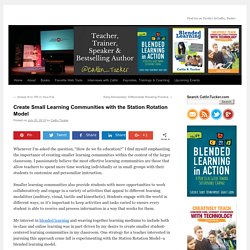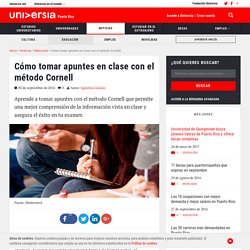

Flipped classroom o clase invertida: constructivismo y el uso de las TICs. Create Small Learning Communities with the Station Rotation Model. Whenever I’m asked the question, “How do we fix education?”

I find myself emphasizing the importance of creating smaller learning communities within the context of the larger classroom. I passionately believe the most effective learning communities are those that allow teachers to spend more time working individually or in small groups with their students to customize and personalize instruction. 7 Educational Transformations for Any Classroom - EdTechTeam. Walking into any store in August will remind you that it’s back to school time.

For some, this may signal that summer is over, but for me, I get goose bumps and my heart races a bit with excitement and anticipation of putting pen to paper and starting anew. It’s an exciting time to be a teacher, and a student, with all of the newest gadgets, apps, and tools available for our use in the classroom. But we all know that the shiny folder, or glitter stickers we love so much is not what makes the beginning of the school year so special. It’s the people who make the difference. Seeing the student’s smiles, the teacher’s high level of engagement with the students, and trying new things together is what makes a classroom a special place. This year I am aiming high with 7 educational transformations. 7 Educational Transformations: 1. 2. 3. 4. 5. 6. 7. Laurie Guyon Integration Specialist. Cómo tomar apuntes en clase con el método Cornell. El método Cornell es una técnica de estudio para tomar apuntes en clase de manera que facilite la adquisición de datos para rendir un examen.

Aunque no existe una mejor forma de tomar notas, el método Cornell permite obtener resultados inmediato cuando estudias, porque sistematiza la nueva información bajo parámetros fáciles de recordar, digerir y reproducir. Conoce cómo funciona su lógica de documentar, releer, autoevaluar, sumariar, recitar y revisar para tener éxito en tu próximo examen. Lee tambiénHarvard: 6 tips para escribir mejor3 consejos con base científica para aprender más9 consejos para estudiar de forma eficiente División de la hoja para tomar notas Estudiar para un examen implica leer libros, escuchar audios, ver videos y repasar notas de clase. La próxima vez que debas tomar nota de materiales de estudio o de lo que explican tus docentes, divide la hoja en secciones separadas por una letra i mayúscula gigante.
We Didn’t Know What We Didn’t Know: Flipped Learning 3.0. By Jon Bergmann and Errol St.Clair Smith Pop Quiz: Most educators know about the Socratic method.

True or false? Let’s go with true. But why was Socrates called the wisest man in the world? The answer? Fast Forward a Couple Thousand Years. Today, with a swipe and a few keystrokes, we can access virtually all the knowledge in the known world from a device that’s smaller than an index card. Best of all, when we’re feeling particularly lazy, we can simply say, “ Hey Siri, who the heck is Socrates anyway?” Yet, despite the super-human ways we can now access knowledge, it’s astounding how often we still don’t know what we don’t know. Flipped learning: Una educación al revés. FLGlobal. Proyectos Flipped y Tic en el aula. Monografico FlippedClassroom. Scaling Flipped Learning Part 1: Technology Strategy – Flipped Learning Simplified. A 2014 study indicates that 46% of U.S. principals expect that new teachers to the profession should already know how to flip a class upon graduation from a teacher training program.

There is also a growing body of research which demonstrates that flipped learning is showing significant growth in student achievement, satisfaction, and teacher satisfaction. As schools begin to implement the model, what kinds and type of support should school leaders provide? This past year I worked with a group of teachers from a variety of schools which was implementing flipped learning into their classes. I was with them three to four times during the year and got to know their successes and challenges. Scaling Flipped Learning Part 2: Shifting Pedagogy – Flipped Learning Simplified. Individual teachers across the world who are flipping their classes, are often working in isolation and small pockets.

However, as the movement has grown, there is an increasing need to think systemically about how to scale flipped learning. I believe three systems need to change for flipped learning to flourish on a large scale in a school or district: technological systems, pedagogical systems, and evaluation methodologies. In part one of this series, I discussed how technological systems need to be integrated, workflows need to be simplified, and technology infrastructure needs to support flipped learning. The focus of this post will be to examine how pedagogical systems need to adapt for flipped learning to thrive on a large scale. Educational researchers have been studying learning for a very long time. Scaling Flipped Learning Part 3: Teacher Evaluation – Flipped Learning Simplified. As more and more schools adopt flipped learning on a larger scale, there is a need to think systemically about evaluation systems.

This is the third in a series on how to scale flipped learning. In the first post I discussed technological systems, in the second I discussed pedagogical systems, and in this post, I will explore how evaluation systems need to change when flipped learning is scaled. During my twenty-four years as a classroom teacher, I was evaluated many times by administrators. The vast majority of these evaluations consisted of the principal sitting in my class and watching me “teach.” Scaling Flipped Learning Part 4: Learning Spaces – Flipped Learning Simplified. “We don’t just want to flip classes; we want to flip schools.”

Ignacio Romero, MT Groupo, Spain This sentiment expressed by Ignacio resounds with me. One of the greatest strengths of flipped learning has been its grassroots nature. It started with teachers trying to do what was best for their students and has grown into a worldwide movement. Scaling flipped learning Part 5: Student Buy-In – Flipped Learning Simplified. As flipped learning continues to grow, there is a greater need for flipped learning to scale beyond individual teachers flipping, to larger roll-outs with systemic planning and leadership.

This post is the 5th out of 7 in a series. The previous posts were:• Part 1: Scaling Flipped Learning: Technological Needs at Scale• Part 2: Scaling Flipped Learning: Pedagogical Needs at Scale• Part 3: Scaling Flipped Learning: Changing Evaluation Systems• Part 4: Scaling Flipped Learning: Learning Spaces • Part 5: Scaling Flipped Learning: Student Buy-In • Part 6: Scaling Flipped Learning: Parent Buy-In (Not yet published) • Part 7: Scaling Flipped Learning: Teacher Buy-In (Not yet published)
Scaling Flipped Learning Part 6: Parent Buy-In – Flipped Learning Simplified. As flipped learning continues to grow, there is a greater need for flipped learning to scale beyond individual teachers flipping, to larger roll-outs with systemic planning and leadership.

This post is the 6th out of 7 in a series. The previous posts were: Sometimes students don’t always communicate with their parent’s accurate information about what is happening in school. Scaling Flipped Learning Part 7: Teacher Buy-In – Flipped Learning Simplified. Scaling Flipped Learning Part 7: Teacher Buy-In As flipped learning continues to grow, there is a greater need for flipped learning to scale beyond individual teachers flipping, to larger roll-outs with systemic planning and leadership. This post is the 7th and final post. The previous posts were: Getting teachers convinced that they should embrace flipped learning is the most important step. Flipped Learning Is The Future And It Is Here - BW Businessworld.
Flipped learning is the new rage on Indian campuses, including in IITs. Flipped learning pioneer Jon Bergmann opens up with BW Businessworld’s Suman K. Jha on its origin and evolution. What is a “flipped classroom”? Flipped learning is a very simple idea. Webinar #1: The Flipped Classroom, por Raúl Santiago. Presentación taller Raúl Santiago. ¿Qué es Flipped Classroom? Clase Invertida (Flipped Classroom en Español) Flipped classroom ¿Cuáles son sus ventajas? ¿Cuál es su origen? ¿Es el flipped learning un modelo eficaz?: 10 estudios que lo confirman. Consejos prácticos sobre cómo implementar el flipped classroom. Más sobre la eficacia del modelo Flipped Classroom. Sobre la eficacia del modelo flipped classroom: (2/2) Más sobre la eficacia del modelo Flipped Classroom (1/3) How to flip the classroom.
Flipping is easy – and with a little thought and planning, teachers can use the flipped model to create engaging learning experiences for their students. This section covers the nuts and bolts of flipping – from creating videos, to introducing the flipped concept, to practical ideas for using class time differently. What are teachers saying? As an English teacher, I have several teaching concepts going at once, so flipping works well for me. I may have kids watch a lesson at home to learn about literary devices in a book we are reading in class. Aprendizaje Invertido -Scoop it. Flippeando. IPad = Flipped Classroom Made Easy. Yes, the Flipped Classroom (Video lessons watched before class time) is a fashionable topic but whilst there’s still chalk-and-talk together with standardised testing I feel I must continue to push it.
And no, it’s not just chalk-and-talk in disguise. It creates a whole new learning environment for the student. I haven’t taught a whole class for 6 months! All my teaching is now one-to-one and not surprisingly, my grades are soaring. Flipped classroom ¿Cuáles son sus ventajas? ¿Cuál es su origen?¿Qué necesitamos para implementarlo? Como implementar la Clase Invertida. Cómo dar una clase al revés o flipped classroom en 5 sencillos pasos.
FASES DEL PROCESO DE DISEÑO DE UNA CLASE INVERTIDA. Algunas ideas prácticas para desarrollar un proyecto FC. Cómo aplicar la pedagogía inversa o flipped classroom en diez pasos. La pedagogía inversa o flipped classroom es un nuevo método que propone dar la vuelta a la clase tradicional e invertir el orden en el proceso de aprendizaje. Frente al modelo de enseñanza habitual, donde el profesor explica la lección en clase y los alumnos escuchan y realizan los deberes en su casa, la flipped classroom concede a los alumnos la responsabilidad de revisar los contenidos teóricos en casa, para que luego puedan resolver sus dudas y trabajar los conceptos en clase de forma individual o colaborativa.
Esta metodología tiene muchas ventajas. Te mostramos cómo aplicarla en el aula mediante un sencillo video tutorial. 1. Programación. 2. 3. 4. 5. 6. 7. 8. 9. 10. M-learning: qué es, para qué sirve y qué usos tiene el en aula. Uso de dispositivos móviles en la evaluación formativa a coste cero en el flipped learning forte. Socrative para profesores dummies.